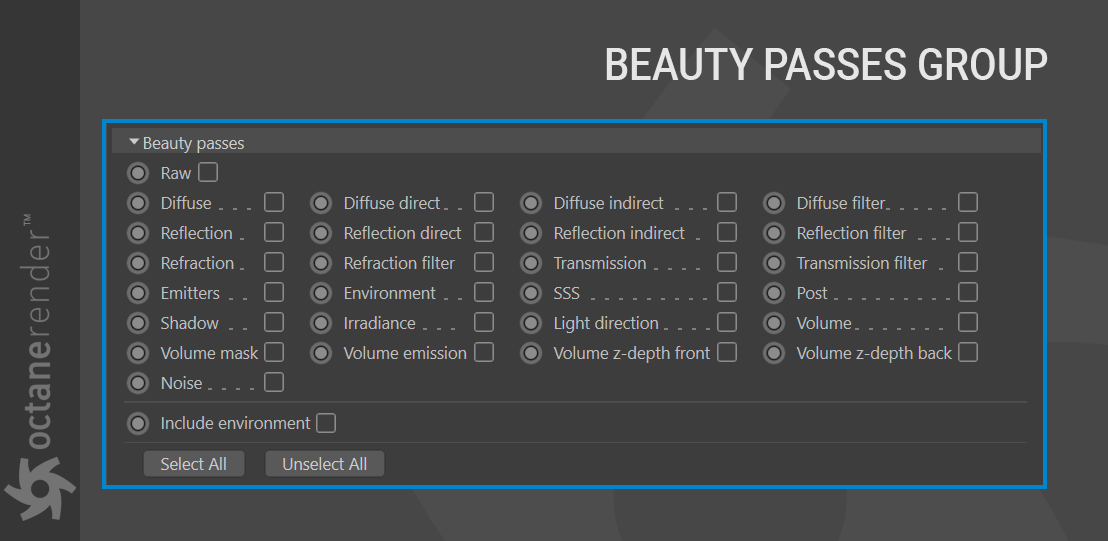- Beauty Passes
- RAW
- DIFFUSE
- DIFFUSE DIRECT
- DIFFUSE INDIRECT
- DIFFUSE FILTER
- REFLECTION
- REFLECTION DIRECT
- REFLECTION INDIRECT
- REFLECTION FILTER
- REFRACTION
- REFRACTION FILTER
- TRANSMISSION
- TRANSMISSION FILTER
- EMITTERS
- ENVIRONMENT
- SSS (SUB-SURFACE SCATTERING)
- POST
- SHADOWS
- IRRADIANCE
- LIGHT DIRECTION
- VOLUME
- VOLUME MASK
- VOLUME EMISSION
- VOLUME Z-DEPTH FRONT
- VOLUME Z-DEPTH BACK
- NOISE PASS
Beauty Passes
Beauty Passes and Beauty Pass AOVs provide a rendered view of different aspects lighting the scene such as shadows, highlights, reflections, illumination, and color. Beauty passes are rendered together with the main beauty pass. Each one of these requires its own frame buffer that needs to be stored in addition to the main frame buffer, therefore choose only those passes that are needed.

RAW
Raw rendering allows more control over the final look in post-production. If you check the Raw button, you will get the image similar to the beauty render. Since you specify the render output format from the file and format field most of the time, you can turn this option off. (Raw divides the beauty surface AOVs by their corresponding filter AOV — you can change the filter AOV in post and then multiply it back with raw AOV and thus can change the color of an object in post, assuming elements are tone mapped in linear color space and devoid of saturated colors. You cannot change elements such as indirect reflections and color bleeding with this method.)
DIFFUSE
The diffuse pass contains all samples where a diffuse material is illuminated, either directly or indirectly.
DIFFUSE DIRECT
The diffuse direct pass contains all samples where a diffuse material is directly illuminated.
DIFFUSE INDIRECT
The diffuse indirect pass contains all samples where diffuse materials are indirectly illuminated (GI).
DIFFUSE FILTER
The diffuse filter pass contains the diffuse texture color of the diffuse and glossy materials.
REFLECTION
The reflection pass contains all of the samples where direct or indirect light is reflected directly or indirectly.
REFLECTION DIRECT
The reflection direct pass contains all samples where light is directly reflected.
REFLECTION INDIRECT
The reflection indirect pass contains all of the samples where indirect light is reflected.
REFLECTION FILTER
The reflection filter pass contains the reflection texture color of the specular and glossy materials.
REFRACTION
The refraction pass contains all samples where camera ray was refracted by specular materials on the first bounce.
REFRACTION FILTER
The refraction filter pass contains the refraction texture color of the specular materials.
TRANSMISSION
The transmission pass contains all of the samples where the camera ray is transmitted by the diffuse materials on the first bounce.
TRANSMISSION FILTER
The transmission filter pass contains all of the transmission texture color of the diffuse materials.
EMITTERS
The emitters pass contains all of the samples where the camera ray hits an emitter.
ENVIRONMENT
The environment pass contains the environment of the scene.
SSS (SUB-SURFACE SCATTERING)
The SSS pass contains all samples that scattered in a volume visible from the camera.
POST
The post pass contains the post-processing applied to the beauty pass. When enabled, no post-processing is applied to the beauty pass itself. Post Processing is controlled by the Octane Camera tag > Post Processing tab, discussed here.
SHADOWS
The shadow pass contains all direct light shadows that are calculated on the first path bounce. The pass includes sun light provided by the Octane Daylight Environment. The Shadow pass excludes the sky light (a.k.a Octane Sun+Sky environment) or texture environment if the texture environment does not consist of an image. If the environment contains a sky light or texture environment that is contributed by an image texture, the pass takes the value in the Environment’s Importance Sampling attribute into account. Make sure to enable Importance Sampling in the Environment to include the sky light or texture environment in the Shadow pass. You can go to this and this section for “Importance Sampling” explanations.

IRRADIANCE
The irradiance pass contains the irradiance on the surfaces.
LIGHT DIRECTION
The light direction pass contains an estimate of the dominant direction from where most of the light is coming.
VOLUME
The volume pass contains all samples that are scattered in a volume.
VOLUME MASK
The volume mask pass contains absorption color and the contribution amount of a volume sample. This is a multiplication pass, so to composite volume passes you should be doing something like (allOtherBeautyPasses)*volume mask + volume + volume emission.
VOLUME EMISSION
The volume emission pass contains all of the samples where the camera ray hit a volume emitter. V
VOLUME Z-DEPTH FRONT
The volume z-depth front pass contains the front depth of all volume samples.
VOLUME Z-DEPTH BACK
The volume z-depth back pass contains the back depth of all volume samples.
NOISE PASS
The noise pass is used to observe the rendering progress through the noise estimate value when Adaptive Sampling is used with the Path Tracing or Direct Light Kernels. A pixel is treated as “noisy” if the noise level is higher than the given threshold. When the noise estimate for a pixel becomes less than the given noise threshold, the value is a green color which also switches off sampling for that pixel and tells the rendering process to concentrate on other areas. This pass shows which pixels have noise lowered down to the specified noise threshold as the rendering progresses. You can go to here for detailed explanation.

